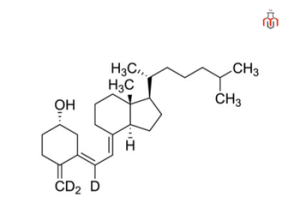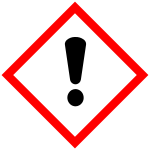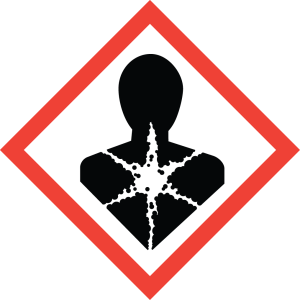
Cholecalciferol is a fat-soluble secosteroid that plays a significant role in dietary supplements indicated for individuals suffering from vitamin D3 deficiency. It is an inactive form of vitamin D, which is converted into calcifediol in the liver and further converted into calcitriol in the kidneys. It helps in calcium intake in the body and cures bone-related disorders like rickets, osteomalacia, and osteoporosis. It also supports the absorption of phosphorus, which is essential for maintaining healthy bones and teeth.

Cholecalciferol undergoes enzymatic conversion in the body to show its biological effects. It is first converted to 25-hydroxyvitamin D in the liver, then further converted in the kidneys to its active form, calcitriol. After that, it binds to vitamin D receptors (VDRs), influencing gene expression, immune function, and bone metabolism.
CAS No.: 67-97-0
Synonyms: Cholecalciferol, Calciol, Vitamin D3
| Physical Properties | |
| Chemical formula | C27H44O |
| IUPAC Name | (3β,5Z,7E)-9,10-secocholesta- 5,7,10(19)-trien-3-ol |
| Molecular weight | 384.6 g/mol |
| State | Crystalline powder |
| Melting point | 83 to 86 °C |
| Storage | 2°C to 8°C |
| Chemical Properties | |
| Color | White to off-white |
| Solubility | Insoluble in water; soluble in organic solvents |
| Odor | Odorless |
| pKa | ~16.0 |
| LogP | ~7.5 |
Its common side effects include –
Sometimes, there may be an allergic reaction like rash, swelling of the face, tongue, or throat, dizziness, and breathing problems.
In a severe condition, it will lead to a rise in calcium levels in the urine (Hypercalciuria) and blood (Hypercalcemia), kidney dysfunction, and cardiac arrhythmias.
| Pictograms : |   |
| Hazard Statements : | H302: Harmful if swallowed |
| Precautionary statements : | P260 Do not breathe dust/fume/gas/mist/vapors/spray. P264 Wash hands thoroughly after handling. P270 Do not eat, drink, or smoke when using this product. P271 Use only outdoors or in a well-ventilated area. P280 Wear protective gloves/ protective clothing. P284 Wear respiratory protection. P301 + P310 + P330 IF SWALLOWED: Immediately call a POISON CENTER |
Cholecalciferol is a fat-soluble secosteroid that plays a significant role in dietary supplements indicated for individuals suffering from vitamin D3 deficiency. It is an inactive form of vitamin D, which is converted into calcifediol in the liver and further converted into calcitriol in the kidneys. It helps in calcium intake in the body and cures bone-related disorders like rickets, osteomalacia, and osteoporosis. It also supports the absorption of phosphorus, which is essential for maintaining healthy bones and teeth.

Cholecalciferol undergoes enzymatic conversion in the body to show its biological effects. It is first converted to 25-hydroxyvitamin D in the liver, then further converted in the kidneys to its active form, calcitriol. After that, it binds to vitamin D receptors (VDRs), influencing gene expression, immune function, and bone metabolism.
CAS No.: 67-97-0
Synonyms: Cholecalciferol, Calciol, Vitamin D3
| Physical Properties | |
| Chemical formula | C27H44O |
| IUPAC Name | (3β,5Z,7E)-9,10-secocholesta- 5,7,10(19)-trien-3-ol |
| Molecular weight | 384.6 g/mol |
| State | Crystalline powder |
| Melting point | 83 to 86 °C |
| Storage | 2°C to 8°C |
| Chemical Properties | |
| Color | White to off-white |
| Solubility | Insoluble in water; soluble in organic solvents |
| Odor | Odorless |
| pKa | ~16.0 |
| LogP | ~7.5 |
Its common side effects include –
Sometimes, there may be an allergic reaction like rash, swelling of the face, tongue, or throat, dizziness, and breathing problems.
In a severe condition, it will lead to a rise in calcium levels in the urine (Hypercalciuria) and blood (Hypercalcemia), kidney dysfunction, and cardiac arrhythmias.
| Pictograms : |   |
| Hazard Statements : | H302: Harmful if swallowed |
| Precautionary statements : | P260 Do not breathe dust/fume/gas/mist/vapors/spray. P264 Wash hands thoroughly after handling. P270 Do not eat, drink, or smoke when using this product. P271 Use only outdoors or in a well-ventilated area. P280 Wear protective gloves/ protective clothing. P284 Wear respiratory protection. P301 + P310 + P330 IF SWALLOWED: Immediately call a POISON CENTER |
Excessive intake of Vitamin D3 can lead to the accumulation of excess calcium in the blood, irregular kidney function, and cardiovascular problems.
Generally, Cholecalciferol is safe when used within the suggested guidelines of dietary and therapeutic doses.
Vitamin D3 helps to regulate keratinocyte differentiation and immune response in the scalp. It is frequently used as a supplement for the hair loss condition of telogen effluvium and alopecia areata.
Vitamin D is a fat-soluble secosteroid essential for calcium and phosphate regulation in the body, while Cholecalciferol is one of its forms, also called Vitamin D3, the natural form synthesized by the skin under sunlight and commonly used as a supplement.
Cholecalciferol is a fat-soluble secosteroid, a form of Vitamin D analog, and is classified as a prohormone that is converted to its active form, calcitriol, in the body.
Cholecalciferol (Vitamin D3) is generally more bioavailable and better retained than Vitamin D2 (ergocalciferol).